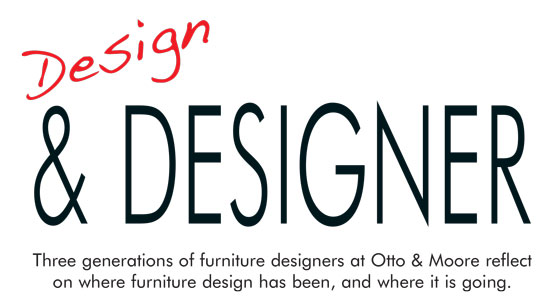
Many Furniture World readers remember seeing furniture styles like Chippendale, Sheraton and Early American on retail selling floors. Empire and it’s various new and old world incarnations were there too.
No longer do legions of consumers shop for formal Queen Ann dining rooms with their signature cabriole legs, wide flaring seats, high polish, and cockle shell motifs, crafted in solid Cherry.
Some things, however, haven’t changed all that much. There is still a lot of sameness at retail, and some say a lack of imagination. At the same time, possibilities have opened up for furniture retailers to be more creative in choosing furniture designs that differentiate their brands.
John Gloag in his excellent book, A Social History of Furniture Design from B.C. 1300 to A.D. 1960, noted that, “Furniture reveals many confidential things about the social life of the past and present; like architecture, it illuminates the story of civilization in nearly every country, and provides an intimate, personal record of habits, postures, manners, fashions and follies.”
At a basic level it’s the professional furniture designer’s job to create furniture that meets certain criteria specified by manufacturers. But the finished products must do more than that. They must address the furniture buyer’s beliefs, physical needs, style sensibilities and budget. As Golag noted, furniture must reflect intimate, habits, postures, manners, fashions and follies.
This issue contains the first in a series of articles that discuss the social, artistic and economic forces that have propelled furniture design to its present state. We will ask what furniture says about our society today, and how it might look in the future.
To do this, Furniture World will speak to leading furniture designers who will share their views about furniture design, it’s form, function, and purpose.
Three Generations
What follows are the thoughts of three generations in the same family of furniture designers at the High Point-based, multiple Pinnacle award-winning furniture design firm Otto and Moore. The generations are represented by William Dudley Moore, Sr., Chairman of the Board/ CEO; his son William Dudley Moore, Jr., President of Otto and Moore; daughter Carolyn Shaw, furniture designer and Vice President; and grandchildren Liz Moore, and William (Will) Dudley Moore, III, also furniture designers.
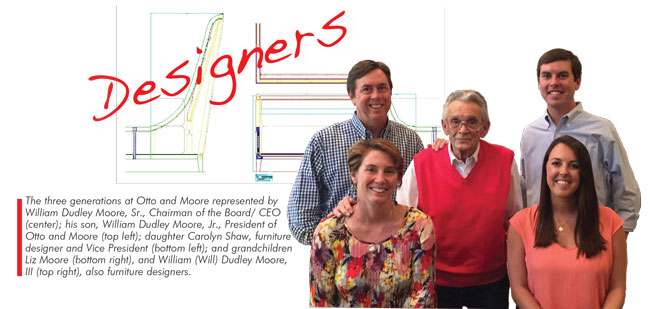
The History
The Moore’s, have deep roots in the furniture industry. “Around the turn of the 20th century,” Says, Dudley Moore, Jr., “my great grandfather owned a successful chair manufacturing business, Home Chair Company, located in the mountains of North Carolina along with two of his three sons. The company was sold to Burlington industries in the early ‘70s. There wasn’t a job in the business for my father, the youngest son.”
“I went to NC State for two years,” Dudley Moore, Sr., continues. “When the Korean War came along, I went into the Air Force, for five and a half years serving as an Aircraft Observer Bombardier. After that, I worked for furniture designer J. Gordon Perlmutter of Plainfield New Jersey. He was quite a famous designer at the time.
“Other well-known designers who worked for Perlmutter early on were Dick Barrow, Irving Sabo, and Marty Lyman. Leonard Eisen was a competitor of ours at that point in time. In 1960, Mr. Hubert Rockwell, who designed furniture back in the 1930s,’40s and ‘50s approached me about coming to work with him and another designer Walter Otto. We established an office, called Rockwell, Otto, and Moore. Walter Otto and I did design work for everybody in the business. Of course, some of these manufacturers are long gone. These were mostly manufacturers we called ‘car-load Charleys’, mid and low priced, such as Bassett and Kemp. We had very little exposure to the upper end at that time, but over the years, our business has grown and Dudley Jr. has been responsible for our success at the high end.”
“In the early ‘70s, Mr. Moore left the business,” adds Dudley Jr., “and the firm became Otto and Moore. We purchased Walter’s interest in the business in the 1980s but kept the name because it was well-known in the industry by that time.”
He notes that he, like many second generation members of family furniture businesses started working early, “as the janitor when I was 12 years old, working my way up to do drafting, studied engineering, then came to work here in 1981.
“I did consider going to design school but wanted to get a broader education so I attended North Carolina State University in Raleigh, that at that time had a curriculum called Furniture Manufacturing and Management. I’ve found what I learned there to be useful for my design work because I know what can be manufactured efficiently, and how to take advantage of machinery that our various clients are using. This allows them to provide more value to their retail customers.”
Carolyn Shaw took a different route, apparently skipping the janitorial work. She’s studied at UNC Chapel Hill. “After graduating with a Studio Art degree,” she says, “I illustrated architecture in Texas for seven years. I had worked at Otto & Moore in high school as an illustrator but didn’t have a furniture design background. In the early 1990s my dad lured me back to the family business where I thought that I would head up the art side of our office that employed five illustrators. In those days we did freehand sketching for the most part, and a small level of engineering on computers. But since that time the business of design has changed drastically. Most of our clients are confident enough in their product direction that they don’t require the illustrations we used to put out. Today we use freelance illustrators and I’ve segued into the design world.”
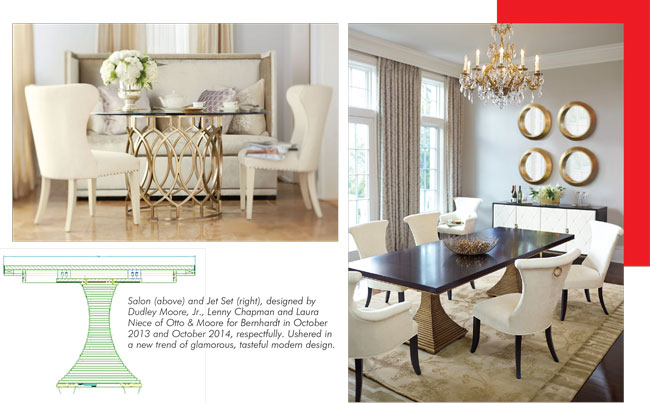
Liz Moore, at 25 years old, had a more formal design education. She told us, “I always had an interest in art and dabbled in furniture design, fashion design, and graphic design.” After attending summer intensive programs at Virginia Commonwealth University and Savannah College of Art and Design she made the decision to study furniture design at Kendall College of Art and Design. Post graduation in 2013, she joined Otto & Moore. “Of course we grew up around furniture design, she explained, “Our grandfathers on both sides of the family were involved in the industry in some way, so it was always on my radar.”
Will Moore adds that his father (Dudley Moore, Jr.) “Really encouraged both Liz and I to make sure we really wanted to go into the furniture business. I started by interning for Outlook International, a case goods quality-control sourcing company in Vietnam. That’s where I became immersed in product development and decided to focus on the merchandising side of the furniture business. After graduating from NC State I worked for Lane Furniture in sales, then moved to the upholstery side with a smaller promotional company. Last year I joined Otto & Moore and have spent that time focusing on the wood portion of the business with an emphasis on the technical side, mechanical, plus chemistry-based. I’m a little bit more technical than Liz, she’s a much better artist than I am, but we make a good team.”
Furniture Design Changes
As noted above, a lot has changed in the business of furniture design since Otto and Moore was founded. Furniture World asked each of the generations to offer their perspectives.
“In my dad’s heyday,” relates Dudley Jr., “furniture designers were more of an instrument. By that I mean that clients came to us saying, ‘We need an 18th century collection, or a Victorian collection,’ or whatever. Clients pretty much understood what the trends were, gave the designer his assignment, and he fulfilled it. Of course, the designer had to have the skill set, the imagination, and the artistic ability to see that vision through.”
“When I came to work here,” agrees Carolyn Shaw, “Otto & Moore designed more lower price point goods. A lot of it was very brassy, and by that I mean we did polyester finishes and furniture with extrusions. These are items that fortunately are not found at retail anymore. At that time manufacturers would come to us with specific, stylistic assignments; such as a request for an 18th century Queen Anne or a Duncan Phyfe group.”
Dudley Sr., has a slightly different take on how the furniture design business has changed. “Back then, if we were instructed to design in a particular direction, we would say to the client, ‘well these folks over here, who are style leaders, have gone in a good direction, and they are being successful, so I think we might go in that same direction.’ That doesn’t mean that we would knock ‘em off.” He observes that the process is not much different than what Otto and More does today with it’s story (mood) boards described later in this article. It’s still a matter of identifying trends in the market to find design directions that will resonate with customers.
The biggest change Otto and Moore’s founder sees is, “Well for one thing, today it’s a hell of a long way to get to the factory! This business of runnin’ back and forth to China is a burden for furniture designers. When I designed for Dixie, which is now Lexington, I just got in the car and drove the 15 miles over there to meet with Henry Link and Smith Young, the guys who were running that company. We decided what we were going to do, and did it. It was a happy time.”
Manufacturers Lose “Design Leader” Status
“Yes, There have been huge changes in the furniture industry since I came into the business,” Dudley Moore, Jr. continues. “Much of that has to do with globalization and the departure of most of the case goods industry from the Southeast. Once furniture started being produced offshore, it changed a lot of design parameters, but the untold bigger effect this has had on our industry is that a lot of the style leaders have passed by the wayside. When I began designing furniture, our industry, like many others, was organized with style leaders selling at higher price points. Lower priced lines took their styling cues from the leaders. From there the trends just tricked down the food chain to the low end.
“Furniture designers who worked at mid-price points often looked to companies like Henredon, Drexel and Thomasville for their design inspirations. For example, Henredon did a group called Scene One. That influenced a Lexington group and then a Stanley group, working its way down. Retailers also utilized style leaders as a road map for what they needed to show on their floors.
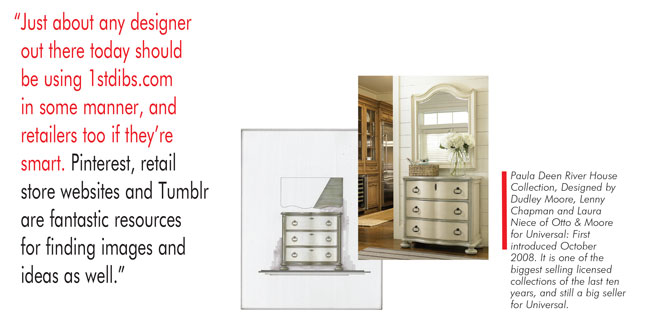
“Because of this trickle down design effect from high to low end, in those days,” Dudley Jr. observes, “a store like Havertys would show multiple Queen Anne-type 18th century-styled collections at different price points. The style was so popular that the purchase decision for consumers was often based mostly on what they could afford to put into their homes.”
Retailers As The New Style Leaders
“The industry doesn’t have that kind of style leadership any more, at least not from the manufacturing side,” Dudley Jr. continues. What’s happened is manufacturing leadership has been replaced to some extent by vertically oriented retailers such as Restoration Hardware that serve as style beacons for others in the industry.”
“The manufacturers we do most of our design work for sell to majors such as Jordan’s, RC Willey, Mathis Brothers, City Furniture and Baer’s. And these guys have to compete with this new generation of retail style leaders. It is an interesting game for them to play. Often they haven’t created the kind of cohesive, style strategy and presentation that allows them to compete directly with operations like Restoration Hardware group.”
Current Furniture Design Trends
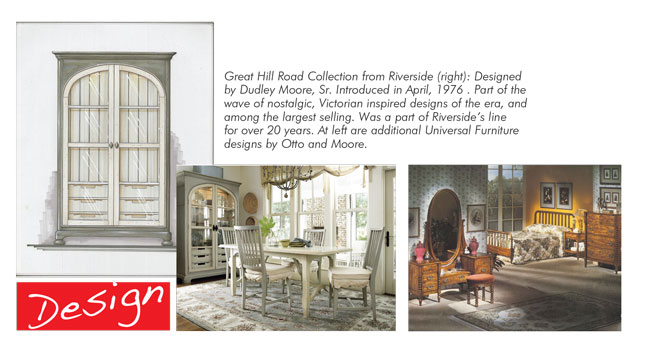
When asked what trends they see at retail, Moore family members identify the following currents in the sea of furniture design choices.
More Lifestyle Driven: “Pure traditional has gone out of fashion,” says Dudley Jr. “Our job would be much easier if those style trends would cycle around like they used to. French would come in for a while, then it would go out, replaced by 18th century. That’s not happening today.
“Furniture design right now is partly driven by lifestyle. The way people live today is so much different than it was, say, 30 years ago. That’s why our industry has seen the decline of the formal dining room category. People want to live much more casually. They want to be comfortable in their homes. They aren’t really trying to make an impression on guests by showing off heirloom looking furnishings. What they really want to own is furniture that their friends are going to think is cool. Also, the fragmentation I mentioned previously at the top of our industry has prevented the kind of leadership on the manufacturing level that consumers can rely on.”
Practical Furniture Designs: Carolyn Shaw tells Furniture World readers, “Younger customers coming along these days are practical. They’re looking for value and for something they can afford, not always for great design. I don’t think that most of them buy furniture thinking that they’re going to own it 30 years down the road. My parents’ generation bought furniture for their lifetime. My father still owns the furniture he bought as a young adult. But, I think that my nephew will be turning his furniture over every 10 years if he can. That type of thinking impacts the quality of the furniture consumers buy today.”
“On the other hand,” Liz Moore, adds, “at the high end, there are still plenty of wealthy people who are going to buy Bernhardt, but just because it’s so beautiful. And they may keep it their lifetime and not turn it over.”
Sustainable Casual Designs: “Today the focus of our age group is on buzzwords like sustainable, organic, natural and casual,” Will Moore tells us, “These are the words that marketers use to describe their designs.
“Instead of traditional versus modern, We are seeing a blend that incorporates low-sheen finishes, and lots of cleaner-looking, casual designs.”
“Most people nowadays prefer a more casual, livable tone,” Liz agrees. “And if we think back to our grandparent’s house, they had formal dining room, formal living room, everything had high-sheen finishes in Mahogany and Walnut. Our generation wants furniture that’s, organic and comfortable. We don’t see as much separation between formal and casual dining. It’s every day dining, and that casual trend applies throughout the house as well.”
Wood Finish Trend: Dudley Moore Jr. says, “The biggest trend we see by far, has more to do with finish than style. Dry finishes, which are almost no-finish, finishes are very strong.”
Wood Species Less Important: “When our grandfather designed furniture,” Liz Moore tells us, “The mindset manufacturers and retailers had was, ‘Oh, it’s mahogany, it’s beautiful, it’s quality, people will want to buy that.’”
Adds Will Moore, “A big trend we are seeing, is less concern about wood species now, especially in the modern genres. Sometimes it’s almost impossible to tell what type of wood a manufacturer is using.”
Relaxed European Styles: Says Dudley Jr., “There’s a major trend moving toward very relaxed, casual European-styles featuring dry finishes on, designs that might have French or Italian influences.”
Disposable & Smaller Scale: “I think younger buyers are looking for multi-functional, smaller scale, apartment style furniture,” Will Moore, suggests. “That’s especially true at the lower-end. There’s a trend we are seeing toward buying disposable furniture, but it’s not clear if it’s a solely income-based behavior. These customers pay a lot less for something, plan to keep it for a couple years and then get rid of it. Even so, they are not going to sacrifice how it looks or how it works. They still want something that they like, think is pretty, and fits well in their living spaces.”
“Also,” adds Liz Moore, “there is a gap in the industry’s understanding of what might be called disposal furniture, that could be addressed a little bit better. I feel like IKEA has it down in their style category. It’s not really quality furniture, but that doesn’t matter to some people. It’s something that the regional chains could really address.”
More Item Buying: “The furniture design business has changed to reflect how our world has changed. Consumers don’t go into retail stores and buy whole groups of furniture anymore. They buy by single items. That’s why Otto and Moore’s groups tend to be more eclectic, and driven more by function and aesthetics instead of style,” says Carolyn Shaw.
Contemporary & Modern: “I think contemporary is coming on, and that Mid-Century modern has really been trying to make it back into the mainstream,” Liz tells us. “A lot of people are afraid of Mid-Century Modern because it’s so specific, but I have a feeling that that’s the trend coming on.” Her father isn’t so sure. “Modern style is definitely having its moment, which is refreshing. Although we’re having a lot of success designing upscale, modern looks, this isn’t the Mid-Century Modern that’s currently very popular with the hipster set and millennials. So far, this group has been buying antiques and flea market-type finds, versus reproductions from typical manufacturers. Several companies have taken a crack at mid-century with limited success.”
Interior Designer Influence: Dudley Moore Jr. sees the growing influence of interior designers. “That’s the result,” he says, “of a changing retail landscape at the higher end.
“Major manufacturers at the higher end, used to sell, in the Atlanta Metro area, for example, Levitz, Rhodes, Roberds, Dillard’s, Farmer’s Furniture, and on and on. All these retailers are gone. Now a lot of the business has gone to retailers like IKEA, Pottery Barn, Rooms To Go, Restoration Hardware, Crate & Barrel, Room & Board, etc. So, whom are these manufacturers going to sell to in Atlanta? In a lot of cases, the interior design trade has helped to fill this gap.”
He says that many of these interior designers have a definite design point of view. “I’m finding that we’re spending more time looking for trends by following interior designers on Instagram and Twitter.”
Coastal Design Trend: “Certainly coastal and cottage are still very popular.” Dudley Jr., explains that this has to do with a larger percentage of the US population living within close proximity to a waterfront.
Todays Furniture Designers
When asked how the creative process looks today, Will Moore says that some in the industry are doing an excellent job designing for their target demographics. “But, from a broader design perspective,” he says, “and especially with some lower-end manufacturing clients, the process is the same as it’s always been. “These manufacturers generally identify a design that’s selling well from another manufacturer to a specific demographic group and ask for a design variation on that theme.”
Given changes in style leadership, Dudley Jr. observes, “There’s so much more confusion in terms of trends. We find that our clients are asking us for help in guiding their style directions, which is in one way liberating, and in another way intimidating. That’s because in a confusing landscape, we can make mistakes too, in terms of trends. We, therefore, have to be more collaborative with our clients, and it puts the onus on us to go to more closed showings and international trade shows than ever before, so we are as up to date as possible.”
“Our clients are much more reliant on us for trendspotting than they were in the past,” he adds.
Liz interjects, “Today, rather than being given an assignment to design an 18th century group, manufacturers ask us to create designs that reflect, for example, a mood such as Rustic Modern or Coastal Cottage. So, instead of starting to design right away, we create a Mood Board for almost everything we do.”
She agrees with her father that design work isn’t as specific as it used to be. “Furniture designers have a little bit more freedom to design in different ways. We don’t have to stick to creating Queen Anne, Chippendale or Art Deco styled groups. Our clients often give us vague terms, such as Modern or Rustic, or Casual Contemporary. They tell us the age group they want to target. Then it’s up to us to come up with ideas for original, beautiful designs that people will enjoy being around at the right price point.”
Mood Boards As Design Tools
“The next step for us” Liz says, “after we find out, for instance, that we are going to design a casual contemporary group is to research what’s out there, find out what other furniture companies are doing. We also look at fashion and architectural influences, consider finishes, and get as much information as we can to update that genre, make it better and salable.”

“Then,” Will adds, “We create a mood board that includes information we’ve gathered from anywhere.” Will says the mood board serves as a focus for generating additional ideas.
Dudley Jr. explains that mood boards are a system of sliding panels that display relevant images. “When we get an assignment from a client, before we ever put pencil to paper, we work to create a story about a collection that fully represents our vision of what it should be, and the way it should feel.”
Says Carolyn, “A mood board, also called a storyboard, tells the story of the design rather than just focusing on the design itself. A typical mood board will deal with color, pattern, texture and other concepts. The result is very much like an advertising presentation. To create it, we pull tear sheets from magazines, and do online research to come up with ideas that reflect the mood we are going after. I use a lot of different tools. One of my favorites is www.1stdibs, an online antique marketplace that thousands of antique stores use. I use it to find clues and ideas which might just be a carving, or an under tight molding, or a piece of hardware.” Carolyn suggests, “Just about any designer out there today should be using 1stdibs.com in some manner, and retailers too if they’re smart. Pinterest, retail store websites and Tumblr are fantastic resources for finding images and ideas.” She also suggests that furniture retailers use mood boards to create design directions for their stores.
Liz says that mood boards “function to get all our ideas together in one place. They serve as a springboard to start the actual design work. Once we get something on paper, we go back and forth with our client, revise sketches, and produce a nice collection.”
“Plus,” Will concludes, “Since many manufacturing executives who make product design decisions are middle-aged white males, “Liz and I, are often asked to give design opinions as members of a younger target demographic.” He says that Liz’s opinion seems to be especially valued for its point of view on style, features and price points.
Next Generation Furniture Designers
Otto and Moore has over the years been a place for young furniture designers to learn their craft.
Dudley Jr., tells us, “It used to be that there were two or three pathways into becoming a successful independent or staff designer.
“The fundamental first step was to work for a big manufacturer like a Henredon or a Thomasville that employed staff designers, to learn the fundamentals. To use a basketball analogy, you would learn how to dribble and defend before learning how to shoot. They would literally throw you out in the factory to learn exactly how a sofa was built and upholstered before they’d ever let you think about designing something.
“Or you could go to work for an independent firm like ours and get the same education. We would, have them start out drafting rudimentary things and then proceed in steps to impart the information needed to become a successful designer.
“That system is gone, and most manufacturers don’t have staff designers anymore. My opinion is that as an industry, the education process for furniture designers is much poorer than it was in years past. There are still excellent schools like Kendall, SCAD, Appalachian and now High Point University, but the young designers we’re seeing do not have the fundamental skills that they might have had 20 years ago. Now, on a more positive note, this has opened up options for us to be more creative in terms of how we find design talent. And, we are finding people who are much more aware of style trends than their predecessors might have been. Since our clients are looking for trendspotting skills, this skill set has been getting more valuable to Otto and Moore over the years.”
When asked if she is optimistic about the future of furniture design, Carolyn Shaw explains, “I’d like to be optimistic and say I’m seeing a lot of improvement in furniture design. There is a lot of great creativity in product design out in the world, but the furniture industry lags behind, and I don’t really know why that is. But I suspect it has to do with furniture designers not having enough time to do the kind of creative work we’d like to do. We are so deadline driven in this industry. There’s always a new introduction that has to be designed and manufactured by High Point Market time. And I think if you ask any furniture designer in this town, they would probably say the same thing.
“I wish that the manufacturers, and importers could slow down enough to let their products run, instead of trying to replace them immediately. They’re always replacing, replacing, and replacing again, designs that aren’t necessarily an improvement.”
She adds that, “As designers we are always trying to improve how furniture functions. Sometimes we get it right and sometimes wrong. When consumers or clients say they are looking for something such as space saving features or specialized areas for storage, we listen. For example, until recently there was evidence that consumers wanted to buy furniture that incorporates features to support technology such as charging stations for hand-held devices in end tables. Then we found out that consumers really weren’t using them. They just kept plugging their devices in right next to the light switches on their countertops.”
Advice for Furniture Retailers
What advice does this group have for Furniture World’s readers?
Dudley Moore, Jr. suggests that retailers could, in general, do a much better job of understanding design. That, he says, is especially true for retail floor sales associates who really don’t understand trends in design like they should. “It is a missed opportunity in terms of sales, because furniture shoppers are much better educated than they used to be. A consumer who comes in because she’s keeping up with trends through social media, print media or broadcast media, knows what she likes, what the trends are, and not only that, has an understanding that’s far beyond the consumer of 20 or 30 years ago concerning what’s hot and what’s not. So, it leaves furniture shoppers cold when they visit a retail floor and have a salesperson tell them, ‘Well, this bedroom is casual contemporary and it’s $999, and this over here is one that’s a coastal design at $1,299, and this one here is rustic and it’s $999.’”
He says this is a problem for many retailers, because their customers are also shopping at the retail style leaders mentioned previously. “At those stores,” he emphasizes, “associates have been trained beautifully to understand a retail culture that focuses on design. That’s not to say there aren’t some who do a great job, but there are many more who could do better.”
“I don’t think traditional retailers are really addressing this trend like they probably could,” Will Moore agrees. “Non traditional retailers like West Elm, Home Goods and IKEA are doing a better job and growing like crazy. There’s definitely a bigger market out there than I think a lot of regional players realize.”
The Final Word
The final word, as is appropriate, comes from William Dudley Moore, Sr. ”I watch Antiques Roadshow every week, and I hope that one of these days one of my pieces of furniture will be on that show.” When asked if he thought that one of his designs for Kemp, Lexington or Bassett would someday be a big money find on Antiques Roadshow, he replies, “Well, I didn’t say that. I said, I hope so.”
Russell Bienenstock is Editor-in-Chief of Furniture World Magazine, founded 1870. Comments can be directed to him at editor@furninfo.com.